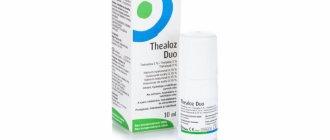Pharmacological properties
Combinil-Duo solution is used in ophthalmic practice as a local antimicrobial and anti-inflammatory agent. Its therapeutic effect is due to the presence of the fluoroquinolone antibiotic ciprofloxacin and the glucocorticosteroid dexamethasone.
Ciprofloxacin has an antibacterial effect and has a bactericidal effect. The effect of the substance inhibits the enzyme DNA gyrase of bacterial microflora, as a result of which DNA replication is disrupted and the synthesis of bacterial cellular proteins stops. Ciprofloxacin is active against reproducing microorganisms, as well as those in the dormant stage. Its antibacterial effect extends to Esherichia coli, Shigella spp., Salmonella spp., most species of Proteus spp., Morganella morganii, Klebsiella spp., Citrobacter spp., Enterobacter spp., Campylobacter spp., Vibrio spp., Hafnia spp., Haemophilus influenzae, Providencia stuartii, Pasteurella multocida, Gardnerella spp., Pseudomonas spp., Legionella pneumophila, Moraxella catarrhalis, Neisseria spp., Acinetobacter spp., Chlamidia spp., Brucella spp. (Gram-negative bacteria). And also: Staphylococcus spp., St. agalactiae, Streptococcus pyogenes, Corynebacterium diphtheria. The toxicity of the substance is negligible.
Dexamethasone is a synthetic glucocorticosteroid commonly used as an anti-inflammatory and immunosuppressive agent. When applied topically, its therapeutic activity is due to its anti-inflammatory, antiallergic, and antiproliferative properties. It reduces the permeability of capillary walls, local exudation, phagocytic activity, and cellular infiltration. Prevents collagen deposition and fibroblast activity, prevents the formation of scar tissue.
The auxiliary component hydroxypropyl betacyclodextrin contained in Combinil-Duo promotes long-term preservation of active substances on the surface of the eye, which increases the effectiveness of the solution.
The prevalence of external ear diseases ranges from 17 to 23% of otiatric pathology. A distinction is made between limited external otitis, or boil, when the process is localized in the membranous-cartilaginous part of the external auditory canal, and diffuse. The causes of external otitis may be water getting into the ear, infection of the external auditory canal, trauma to the skin of the external auditory canal, high ambient temperature, mechanical removal of earwax, which is a protective barrier to the development of infection, foreign bodies, the use of hearing aids, eczema, psoriasis, seborrheic dermatitis [1, 2].
It is known that common pathogens of external bacterial otitis are Pseudomonas aeruginosa, Staphylococcus aureus, Staphylococcus epidermidis, Escherichia coli, Proteus vulgaris
and others [3-8]. The clinical manifestations of diffuse otitis externa are pain in the ear of varying intensity, a feeling of fullness and itching in the ear.
An important stage of treatment is timely sanitation of the outer ear from purulent discharge. To do this, the ear is cleaned, the external auditory canal is washed with antiseptic solutions, and various antibacterial agents are used, which can be used both on the ear and in the form of drops. Thus, targeted transport of medicinal substances to the site of inflammation is achieved, which ensures a high concentration of the medicinal substance in the area of inflammation. It is important that with this method of treatment, the effect of the drug on the macroorganism is minimal due to the low absorption of the drug into the blood [1, 2, 9].
The purpose of the study was to increase the effectiveness of treatment of patients with diffuse external otitis by including Combinil-Duo ear drops (Promed Exports, India) in the treatment regimen.
Combinil-Duo contains 2 active components: 0.3% solution of ciprofloxacin and 0.1% solution of dexamethasone. This is the first and currently the only combination of fluoroquinolone and corticosteroid in the form of drops in our country. Ciprofloxacin is a second-generation fluoroquinolone, a broad-spectrum antibiotic, the gold standard in the treatment of Pseudomonas aeruginosa, which is very important, since treatment of otitis usually begins before the results of bacteriological examination.
Fluoroquinolones have a bactericidal effect. They belong to the group of drugs that disrupt the synthesis of nucleic acids and inhibit the key enzyme DNA gyrase, which is responsible for DNA synthesis. This enzyme ensures the unwinding of DNA superhelixes necessary for its replication. This disrupts DNA synthesis and, consequently, the growth and division of bacterial cells. Inhibition of DNA gyrase activity is lethal to bacterial cells.
Combinil-Duo drops have an advantage over other combination drugs because they are one of the few drugs that do not have an ototoxic effect. For this reason, their use is also relevant for diffuse external otitis, since the eardrum is not always visible due to strong infiltration of the skin of the external auditory canal and for this reason it is impossible to accurately determine its integrity.
Dexamethasone reduces capillary permeability and proliferation, local exudation, cellular infiltration, and phagocytic activity. Thus, it has a powerful local anti-inflammatory, anti-allergic and anti-proliferative effect, and also indirectly reduces ear pain, which is very important, since the most common complaint with otitis externa is pain and itching.
Patients and methods
For 6 months 2012-2013. at the Department of Otorhinolaryngology named after. acad. I.B. Soldatov Samara State Medical University of the Ministry of Health of the Russian Federation treated 55 patients with diffuse external otitis. The age of the patients was from 18 to 73 years, the average age was 45.5±7.8 years.
2 groups were formed. The 1st, main group included 30 patients who were treated with Combinil-Duo. The 2nd comparison group was formed of 25 patients who received local treatment of diffuse external otitis with drops of an aminoglycoside antibiotic. The course of treatment was 7 days. Treatment usually began on the 2-4th day from the onset of the disease. Patients in both groups received drops for 7 days, on the first day - on the turunda, and subsequently - by injecting 3-4 drops into the external auditory canal. Before the start of the study, no patient received antibacterial treatment.
Previously, the ear was toileted, rinsed with a Janet syringe or using a Hartmann cannula. In the main group, we used Combinil-Duo ear drops 2 times a day. The choice of antimicrobial drug was carried out empirically, taking into account literature data on the flora of otitis media and the clinical picture, since we received the result of bacterial culture of the contents from the ear for microflora and sensitivity to antibiotics only after 7-10 days from the start of treatment. In the comparison group, treatment was carried out with drops containing an antibiotic from the aminoglycoside group - framycetin sulfate, as well as gramicidin and dexamethasone, drops were used 3 times a day.
Systemic antibacterial therapy was not prescribed, although body temperature before treatment was elevated in 11 patients from the main group and 7 patients from the comparison group. But by the 3rd day of treatment it returned to normal in all patients. The study did not include patients with diabetes mellitus who are allergic to fluoroquinolone antibiotics; as well as those who complained of severe itching in the ears, a history of otomycosis was confirmed.
The criteria for the effectiveness of treatment were normalization of the general condition of patients, cessation of pain and pathological discharge from the ear, normalization of the otoscopic picture, and restoration of auditory function.
The severity of various complaints (ear pain, ear congestion, pulsating noise in the ear) was reflected on a 10-point scale, and changes in the amount of purulent discharge from the ear, hyperemia and infiltration of the walls of the external auditory canal were assessed on a 5-point scale, where 0 is the absence characteristic, and 5 points is its maximum severity.
All patients underwent the following studies: collection of complaints and medical history, endoscopy of ENT organs, general blood test (leukocytes, erythrocyte sedimentation rate), microbiological study of ear flora, pure tone threshold audiometry. Treatment results were expressed in points.
The results of the study were assessed on days 3, 5, 7 and 10 from the start of treatment.
Results and discussion
Microbiological examination revealed various microflora (Fig. 1 a, b).
Figure 1. Results of microbiological examination of ear discharge in the main (a) and control (b) groups before treatment.
Pseudomonas aeruginosa
was isolated as the main pathogen . When determining the sensitivity of pathogenic microflora, a high degree of sensitivity to ciprofloxacin was determined.
According to pure tone threshold audiometry, patients with diffuse otitis externa had a small air-bone interval of 15-20 dB at low frequencies, and hearing loss with air conduction of sound ranged from 10 to 20 dB. By the end of treatment in patients with diffuse external otitis, the bone-air gap was eliminated in all patients included in the study. By the 10th day, all patients with diffuse external otitis had no complaints, the otoscopic picture was normal.
The results of the study indicate the benefits of using Combinil-Duo ear drops in the treatment of diffuse external otitis. This is confirmed by statistically significant differences between the subgroups, indicating a more pronounced clinical effect in the main subgroup.
Thus, in the main subgroup of patients with diffuse external otitis, ear pain decreased significantly already on the 3rd day of treatment, and on the 5th it almost did not bother the patients (Fig. 2 a).
Figure 2. Dynamics of signs of “ear pain” (a), “ear congestion” (b), “hyperemia” (c) and “infiltration” (d) of the skin of the external auditory canal in patients with external diffuse otitis in the main and control groups.
Ear congestion in the main group decreased faster on the 5th day of treatment than in the comparison group (Fig. 2 b)
.
According to otoscopy, inflammatory phenomena in the form of hyperemia and infiltration of the skin of the external auditory canal in the group where treatment was carried out with Combinil-Duo ear drops stopped much faster, already from the 3rd day (Fig. 2 c, d)
.
Conclusion
The study showed the high effectiveness of the drug Combinil-Duo in the treatment of diffuse external otitis.
Clinical symptoms, starting from the 3rd day of treatment, were relieved more quickly in the group receiving Combinil-Duo than in the comparison group. When using a combination of ciprofloxacin and dexamethasone, a significant reduction in signs of the disease such as ear pain, ear congestion, hyperemia and skin infiltration of the external auditory canal was noted.
It is also important that the drug Combinil-Duo is easy to use, does not cause unwanted side effects and is not ototoxic, since due to the strong infiltration of the skin of the external auditory canal, the integrity of the eardrum cannot always be determined.
Directions for use and doses
The standard regimen for using the Combinil-Duo solution involves the conjunctival application of 1-2 drops of the drug every 4 or 6 hours. During the first two days, installations are prescribed every 2 hours.
Duration of treatment:
- Acute bacterial conjunctivitis and blepharitis - course 5 - 14 days.
- Keratitis - course 2 - 4 weeks.
- Prevention of surgical infections - course 5 - 30 days.
When using Combinil-Duo for more than 10 days, monitoring of intraocular pressure is mandatory.
Side effects
- Infiltrates in the cornea, burning, itching, redness of the eye.
- Conjunctivitis, keratitis.
- Swelling of the face, periocular edema, sensation of a foreign body in the eye.
- Photophobia, blurred vision, dry eye syndrome.
- Redness of the conjunctiva, swelling of the eyelids.
- Glaucoma, cataracts, optic nerve damage.
- Thinning of the cornea, narrowing of the fields and decreased visual acuity, perforation of the eyeball.
- Secondary infection (bacteria, fungi).
- Distortion of taste.
- Skin rash.
special instructions
Unreasonably long-term use of Combinil-Duo solution can lead to an increase in intraocular pressure, which leads to damage to the optic nerve, the formation of cataracts and a decrease in visual acuity.
When acute purulent eye infections are treated with corticosteroids, the symptoms of the disease may worsen or be masked.
Patients using contact lenses should remove them before each instillation of Combnil-Duo. They can be put on again only 20 minutes after the procedure, since the preservative in the solution can have a negative effect on contact correction devices.
After using the drug, you should not immediately get behind the wheel or start working with complex mechanisms due to the resulting temporary visual impairment.
The bottle should be tightly closed after each use. Do not touch the dispenser to any surfaces.
Store the Combinil-Duo solution at room temperature in a dark place. Not given to children.
The shelf life of the unopened solution is 2 years. The opened solution is good for one month.
Combinil-duo 5ml eye/ear drops
Release form
Eye and ear drops.
Package
There is 5 ml of the drug in a plastic dropper bottle. In a cardboard package there is 1 dropper bottle. 5 ml
pharmachologic effect
Combinil is intended for local use in ophthalmological and otorhinolaryngological practice. The therapeutic effect of the drug Combinilo is due to the antimicrobial effect of ciprofloxacin and the anti-inflammatory effect of dexamethasone. Ciprofloxacin is an antimicrobial drug from the fluoroquinolone group, has a wide spectrum of antibacterial action and has a bactericidal effect. The drug inhibits the enzyme DNA gyrase of bacteria, as a result of which DNA replication and the synthesis of bacterial cellular proteins are disrupted. Ciprofloxacin acts both on microorganisms that are reproducing and those in the dormant stage. The spectrum of antibacterial action of ciprofloxacin includes: Gram-negative microorganisms: Escherichia coli. Salmonella spp. Shigella spp. Proteus spp. (indole-positive and indole-negative). Morganella morganii. Citrobacter spp. Klebsiella spp. Enterobacter spp. Vibrio spp. Campylobacter spp. Hafnia spp. Providencia stuartii. Haemophilus influenzae. Pasteurella multocida. Pseudomonas spp. Gardnerella spp. Legionella pneumophila. Neisseria spp. Moraxella catarrhalis. Acinetobacter spp. Brucella spp. Chlamydia spp. Gram-positive microorganisms: Staphylococcus spp. Streptococcus pyogenes. St. agalactiae. Corynebacterium diphtheriae. Listeria monocitogenes. The drug is low toxic. Dexamethasone is a synthetic glucocorticosteroid primarily used as an anti-inflammatory and immunosuppressive agent. When applied topically, the therapeutic activity of dexamethasone is due to its anti-inflammatory, antiallergic and antiproliferative effects. It reduces capillary permeability and proliferation, local exudation, cellular infiltration, phagocytic activity, collagen deposition and fibroblast activity, and inhibits the formation of scar tissue. Thus, dexamethasone reduces the main symptoms of inflammation.
Pharmakinetics
Absorption and metabolism When used in ophthalmology, ciprofloxacin penetrates well into various tissues of the eye, with the exception of the lens. C max occurs within 30 minutes, the highest concentration is observed in the moisture of the anterior chamber. Systemic reabsorption is observed. However, the drug concentration achieved in the blood is well below the detection limit and has no clinical significance. Dexamethasone, after instillation into the conjunctival sac, penetrates well into the corneal epithelium and conjunctiva; at the same time, therapeutic concentrations are achieved in the aqueous humor of the eye; with inflammation or damage to the mucous membrane, the penetration rate increases. When used in otorhinolaryngological practice, when a fixed combination of ciprofloxacin and dexamethasone is administered into the ear canal, the maximum serum concentration for ciprofloxacin is 1.55 ng/l, and for dexamethasone 0.86. ng/l. Elimination The half-life of the drugs is 2.9 hours and 2.8 hours, respectively. Hydroxypropylbetacyclodextrin, which is part of the drug as an auxiliary component, promotes long-term preservation of the active substance on the front surface of the eye, thereby increasing the effectiveness and duration of action of the drug.
Indications
Bacterial inflammatory diseases of the eye and its appendages: Acute and subacute conjunctivitis. Keratitis. Anterior uveitis. Blepharitis and other inflammatory diseases of the eyelids. Prevention and treatment of infectious complications after injuries to the eye and its appendages and during operations on the eyeball. Bacterial inflammatory diseases of the ear: Acute external otitis. Acute otitis media with eardrum shunt. Acute otitis media with granulations and otorrhea in the presence of an eardrum shunt.
Contraindications
Hypersensitivity to the active substance of the drug or to any auxiliary ingredients included in this dosage form of the drug. Herpetic keratitis and other viral lesions of the cornea and conjunctiva. Tuberculosis of the eye. Fungal infections of the eyes. Viral infections of the ear canal. Perforation of the eardrum. Children under 18 years of age. Pregnancy. Breastfeeding period.
Use during pregnancy and breastfeeding
Contraindicated during pregnancy and breastfeeding.
special instructions
For bacterial inflammatory diseases of the ear Before using ear drops, the external auditory canal should be sanitized (rinse and dry the external auditory canal). Before instilling the drug into the external auditory canal, you should warm it to body temperature by holding it in your hands for 1-2 minutes. It is necessary to lie on your side or tilt your head back to facilitate instillation. Place the indicated number of drops into the external auditory canal. Allow the drops to drain into the external auditory canal, pulling the earlobe down and back. Keep your head tilted back for about 2 minutes. You can place a cotton wool pad in the external auditory canal. For bacterial inflammatory diseases of the eye and its appendages, long-term use can lead to an increase in intraocular pressure with subsequent damage to the optic nerve, a decrease in visual acuity and fields, as well as the formation of posterior subcapsular cataracts. When using the drug Combinil-Duo for more than 10 days, it is necessary to monitor intraocular pressure. For acute purulent eye infections, corticosteroids may worsen or mask symptoms. Long-term use of the drug may reduce the immune response and lead to the development of secondary eye infections. Patients using contact lenses should remove them before instillation of the drug and put them back on only after 20 minutes, since the preservative contained in the drug may have an adverse effect on the eye tissue. The bottle must be closed after each use. Do not touch the tip of the pipette to your eye. Effect on the ability to drive vehicles and machinery After using the drug, the clarity of visual perception may decrease; therefore, immediately after instillation, it is not recommended to drive a car or engage in activities that require increased attention and speed of psychomotor reactions.
Compound
1 ml contains: Active substances: dexamethasone 1 mg, ciprofloxacin (in the form of hydrochloride) 3 mg; Excipients: benzalkonium chloride, hydroxypropyl betadex, disodium edetate, mannitol, hydrochloric acid (up to pH 4.0), water for injection.
Directions for use and doses
For bacterial inflammatory diseases of the eye and its appendages, 1-2 drops are instilled into the conjunctival sac every four to six hours. The first 24-48 hours of installation can be done every two hours. For bacterial inflammatory diseases of the ear, 4 drops into the external auditory canal of the affected ear twice a day for 7 days. You should not change the position of your head for 60 seconds to ensure complete penetration of the drug into the ear canal. Course of treatment: for acute bacterial conjunctivitis, blepharitis - from 5 to 14 days. For keratitis - 2-4 weeks. For the prevention of inflammatory diseases after surgical interventions with perforation of the eyeball - from 5 days to 1 month. If the drug is used for more than 10 days, the patient's intraocular pressure should be monitored.
Side effects
On the part of the visual organs: Corneal infiltrates, burning, redness, itching of the eyes, conjunctivitis, keratitis, periocular edema, facial edema, foreign body sensation in the eye, photophobia, blurred vision, dry eye, eyelid edema, conjunctival hyperemia, glaucoma and optic nerve damage, decreased visual acuity and narrowing of visual fields, cataract formation, secondary infection (fungal and bacterial), thinning of the cornea and/or perforation of the eyeball, delayed wound healing. On the part of the hearing organs: Discomfort and pain in the ear, itching in the ear, ear congestion, taste perversions, skin rash.
Drug interactions
Systemic absorption when applied topically is negligible, so the likelihood of drug interactions is extremely low. Inducers, inhibitors and substrates of liver enzymes Drugs that induce the activity of cytochrome P450 3A4 (CYP 3A4) (barbiturates, phenytoin, carbamazepine, rifampicin) can enhance the metabolism of corticosteroids. Drugs that induce CYP3A4 activity (ketoconazole, macrolides) can potentially cause an increase in plasma corticosteroid levels. Dexamethasone is a moderate CYP3A4 inducer. Co-administration with drugs metabolized by CYP3A4 (erythromycin) may increase their clearance, reducing their plasma concentrations. Combination of ciprofloxacin with other antimicrobial drugs When ciprofloxacin is combined with other antimicrobial drugs (beta-lactam antibiotics, aminoglycosides, clindamycin, metronidazole), synergism is usually observed. Can be successfully used in combination with azlocillin and ceftazidime for infections caused by Pseudomonas spp. With mezlocillin and other beta-lactam antibiotics - for streptococcal infections. With isoxazolylpenicillins and vancomycin - for staphylococcal infections. With metronidazole and clindamycin - for anaerobic infections.
Overdose
Symptoms: the occurrence of punctate keratitis, erythema, increased lacrimation, swelling and itching of the eyelids. Treatment: there is no specific antidote. You should rinse your eyes with water, discontinue the drug and prescribe symptomatic therapy. There are no data on systemic manifestations of overdose.
Storage conditions
In a place protected from light, at a temperature not exceeding 25°C. Do not freeze. Shelf life: 2 years.
Conditions for dispensing from pharmacies
Dispensed with a doctor's prescription






